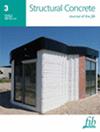Simplified modified tension chord model: An alternative crack width calculation model to Eurocode 2 and fib model codes
IF 3.3
3区 工程技术
Q2 CONSTRUCTION & BUILDING TECHNOLOGY
引用次数: 0
Abstract
This paper proposes a new design code formulation for calculating crack widths for regular and more special reinforced concrete (RC) members. The more comprehensive Modified Tension Chord Model (MTCM) has been simplified (SMTCM) to facilitate an alternative method for calculating crack widths to Eurocode 2 and简化的改良拉弦模型:欧洲规范 2 和纤维模型规范的另一种裂缝宽度计算模型
本文提出了一种新的设计规范公式,用于计算普通和更特殊的钢筋混凝土 (RC) 构件的裂缝宽度。更为全面的修正张弦模型(MTCM)已被简化(SMTCM),以便为计算欧洲规范 2 和纤维模型规范的裂缝宽度提供一种替代方法。该模型以机械原理为基础,未作经验性修改,并以先前公布的实验裂缝宽度数据库为基准。SMTCM 预测裂缝宽度的准确度与 MTCM 相当,而且适用范围更广,例如适用于大型盖板和具有任意钢筋配置的 RC 拉杆,因此是比当前 RC 拉杆设计规范更好的裂缝宽度模型。此外,不会出现对计算结果解释不清的情况,这可能会增加从两个不同设计者处获得两种不同裂缝宽度的风险。为了进一步证明 SMTCM 代码的制定和概念,我们使用并讨论了几条具有实验裂缝宽度剖面的 RC 拉杆。结果表明,根据混凝土覆盖层和钢筋尺寸的不同,表面和钢筋位置的裂缝宽度剖面存在很大差异。这些观察结果对耐久性设计和要求很有意义,并表明应进一步研究将特定表面的最大设计裂缝宽度作为决定性参数的方法,特别是对于大面积混凝土覆盖层。
本文章由计算机程序翻译,如有差异,请以英文原文为准。
求助全文
约1分钟内获得全文
求助全文
来源期刊

Structural Concrete
CONSTRUCTION & BUILDING TECHNOLOGY-ENGINEERING, CIVIL
CiteScore
5.60
自引率
15.60%
发文量
284
审稿时长
3 months
期刊介绍:
Structural Concrete, the official journal of the fib, provides conceptual and procedural guidance in the field of concrete construction, and features peer-reviewed papers, keynote research and industry news covering all aspects of the design, construction, performance in service and demolition of concrete structures.
Main topics:
design, construction, performance in service, conservation (assessment, maintenance, strengthening) and demolition of concrete structures
research about the behaviour of concrete structures
development of design methods
fib Model Code
sustainability of concrete structures.
 求助内容:
求助内容: 应助结果提醒方式:
应助结果提醒方式:


